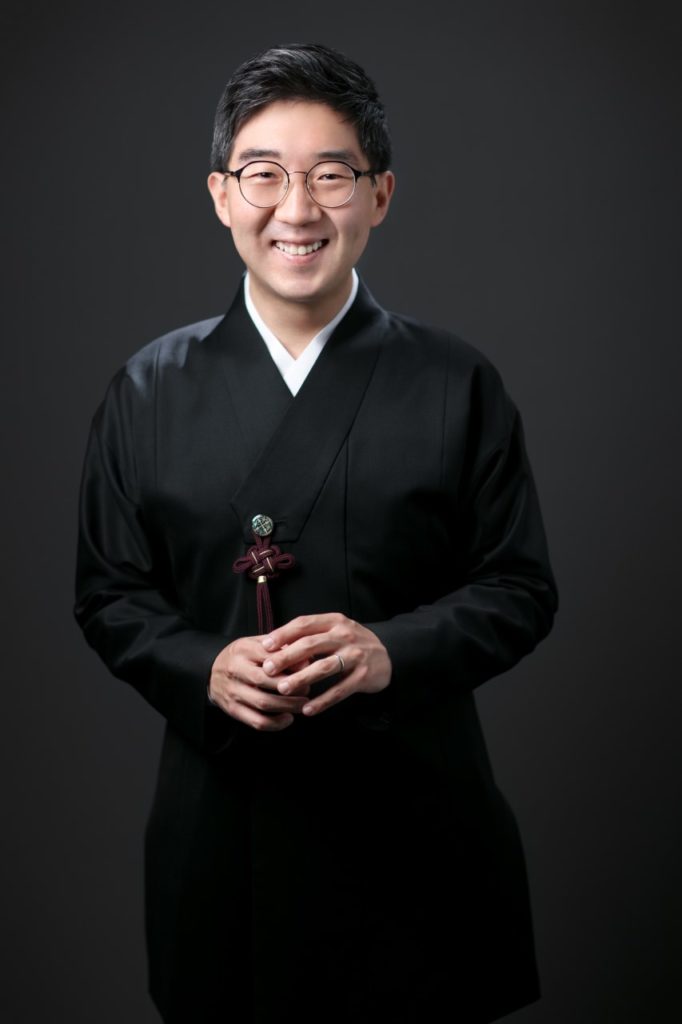Commissioned Work ‘Mir’ by Texu Kim Premiered at Spreckels Summer Organ Festival
Monday’s concert at the Spreckels Organ Pavilion proved extraordinary for several reasons. The program featured two organists, our Civic Organist Raúl Prieto Ramírez and guest organist Jaebon Hwang, a complete brass octet, the première of a commissioned work by the festival’s Featured Guest Composer Texu Kim, and the opportunity to see our Civic Organist conduct!
Drawing on Korean folklore for the concept and title of his work for organ and brass octet, Kim calls his piece “Mir,” the Korean word for dragon. In his introductory words, Kim explained that when worthy serpents have achieved their full potential and transform into good dragons, celebration occurs in the animal kingdom. And we Occidentals naively thought that dragons were exclusively evil!“Mir” opens with a muffled rumble from the organ’s lowest pipes, perhaps symbolizing the subterranean world where snakes reside, followed by high-pitched trills that announce a jaunty tune for the full brass octet. With four brass players flanking each side of the organ console, Ramírez was able to conduct the brass when his hands were not occupied on the manuals. Much of the brass writing suggests jubilant processions punctuated by rousing fanfares. Kim’s polished, fluent style is comfortable with tonality, but his themes and progressions avoid cliched predictability. Throughout the piece, Kim has provided a number of charming solo themes for the organ, and Ramírez chose winning colors from the many possibilities found in the Spreckels’ Austin organ. “Mir” ends with a brilliant organ solo to which the brass adds great sonic muscle—the dragon flies off to high adventure?
For sheer sonic bliss, it was hard to beat Ramírez’ smashing arrangement for organ and brass octet of the “Finale” from Alexandre Guilmant’s First Concerto for Organ and Orchestra. He adroitly unleashed the majesty of the Spreckels Organ through the composer’s grand symphonic style, to which the brass added another rich sonority as well as gleaming, arched themes.Adding to the brio of high French Romantic style, Ramírez gave a dashing account of Eugène Gigout’s “Grand Choeur Dialogué,” which allowed him to show off the splendor of the instrument’s generous reed choruses.
But nothing could touch the fire of Ramírez’ own solo organ arrangement of Camille Saint-Saëns’ “Danse macabre.” Although the colorful orchestral version of this work is well-known—it may be the composer’s most popular composition—the orchestral version itself is a transcription. Saint-Saëns’ original “Danse macabre” was a song for voice and piano, and he turned it into a devilishly clever tone poem.
Whenever Ramírez brings out his “Danse macabre,” each time it appears that he has added some additional flourish in his registration or performance that increases the excitement of the piece, and at the same time creatively employs the wide range dynamic control as well as the array of percussion stops the instrument possesses. When the Spreckels’ Austin was installed in 1915, this was the apex of the “orchestral organ,” i.e., the style of organ building whose main goal was to convincingly transcribe orchestral music. While the Spreckels’ organ has been significantly expanded over the years, its heart is still that orchestral core with its wide array of requisite mechanical percussion effects. Organists affectionately call this percussion collection “the toy counter.”
Among the more compelling arrangements for brass and organ, David Mariatt’s revision of Claude Debussy’s piano solo “La fille aux cheveux de lin” surprised me with its understated allure. Dulcet trumpet melodies and feathery organ stops muffled behind the closed shutters gave this gossamer prelude surprising presence. In a transcription of Sergei Rachmaninoff’s song “Oh, Never Sing to Me Again,” trumpeter Christopher Smith interpreted the vocal line with great sensitivity while Ramírez crafted a suave arrangement of the piano part for the organ.
Ramírez conducted three Canzonas by Giovanni Gabrieli written for three distinct choirs, realized by two brass quartets and Jaebon Hwang playing the third ensemble on the Spreckels organ. At the turn of the 17th-century in Venice’s grand St. Mark’s Basilica, each of these instrumental choirs would have been placed in a different balcony, and the antiphonal effect of the writing was both novel and astonishing. But with the two brass ensembles sitting in directly front of the Spreckels organ, this clever interplay was difficult to detect, and the performers’ unembellished lines melted together into a bland extended rhythmic chorale.
In addition to Christopher Smith, the brass octet included trumpets Roy Nowak and Jonah Levy; trombones Kyle Covington and Kyle Mendiguchia; horns Darby Hinshaw and Tricia Skye from the roster of the San Diego Symphony, and tuba Scott Sutherland.
This concert was presented by the Spreckels Organ Society on Monday, August 14, 2023, in Balboa Park’s Spreckels Organ Pavilion.

Ken Herman, a classically trained pianist and organist, has covered music for the San Diego Union, the Los Angeles Times’ San Diego Edition, and for sandiego.com. He has won numerous awards, including first place for Live Performance and Opera Reviews in the 2017, the 2018, and the 2019 Excellence in Journalism Awards competition held by the San Diego Press Club. A Chicago native, he came to San Diego to pursue a graduate degree and stayed.Read more…



WOW! Thank you Ken! I wish I had been there! My best to you, Dear Friend!